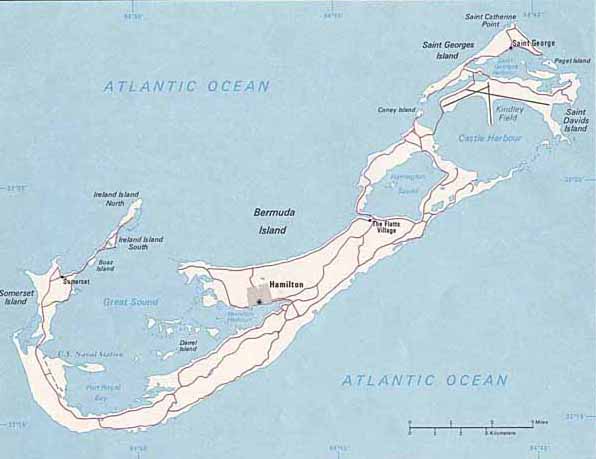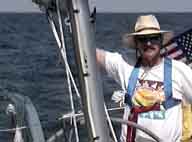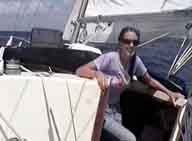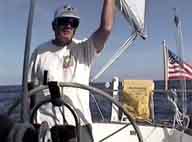In the summer of 2001 five friends and I cruised my Pearson 424 ketch from the Chesapeake Bay to Hamilton, Bermuda and return. This is a record of that cruise.

Here is the itinerary and crew for the 2001 cruise from the Chesapeake Bay to Bermuda and return.
| Cruise Leg | Departure | Arrival |
| Town Creek to Bermuda | Sunday, June 24, 2001 13:00 EDT | Sunday, July 1, 2001 04:30 EDT |
| Bermuda to Town Creek | Friday, July 6, 2001 12:00 EDT | Saturday, July 13, 2001 16:30 EDT |
Crew List
| Town Creek to Bermuda | Bermuda to Town Creek |
|
John Stevenson |
John Stevenson |
|
Mike Repass |
 Mike Repass |
|
Liz Repass |
 Liz Repass |
|
Dick Juppenlatz |
 Dick Juppenlatz |
|
Steve Angst |
 Frank Palumbo |
Sarah is a 1978 Pearson 424 ketch.
| Fresh water capacity | 150 gal |
| Fuel capacity | 80 gal |
| Sail inventory | 120 Genoa, Fully battened mainsail and mizzen, working jib, asymmetrical spinnaker, storm jib. |
| Engine | Westerbecke 60 |
There are three potential sea berths on Sarah. The two settees in the man cabin were converted to sea berths through the addition of sea clothes. A sea cloth also was fitted to the berth in the aft cabin. The v-berth in the forward cabin was used to store duffel bags and other personal articles during the trip.
With a crew of five persons, we elected to go with a straight three hour watch schedule. Each person in the crew stood a three hour watch followed by either four or five hours off watch. This seemed to be the best combination of a simple schedule and one that provided sufficient time off watch to allow everyone keep up on their sleep.
Prior to departure we established the watch checklist. This is a list of checks that must be performed by each crew member when coming on or going off watch. These checks were meant to establish the status of the vessel at the beginning or end of the watch, and insure that any problems are identified early and corrected as soon as possible. The checklist included the following items.
- Check level of water in the bilge. Take action if significant water has accumulated.
- Cabin Tour: Walk the entire extent of the cabin. Note any unusual smells or sounds
- Turn off any unused lights
- Check the battery voltage at the electrical panel. If voltage is below 12v switch batteries and recharge low battery.
- Check DC Electrical Panel to insure unnecessary circuits are turned off. A list of active circuits will be posted at the navigation station. Any active circuits that are not on the list should be turned off unless someone is using them (e.g. cooking with the propane stove or reading).
- Check refrigerator temperature. If above 40 deg F., start engine and turn on compressor. Run for 1 hour or until temperature is reduced to at least 38 deg F..
- Deck Tour: Conditions permitting, the person coming on watch should proceed from the cockpit to the bow on one deck and then return to the cockpit on the other deck. The watch person should note the condition everything on deck. Anything that looks out of order should be corrected before the previous watch retires. At a minimum the following items should be checked and corrected if not in order.
- Halyard tails properly coiled and secured.
- Life raft properly secured to cradle.
- Anchors properly secured in rollers.
- Anchor rode deck pipe properly secured
- Anchor locker cover properly secured.
- Dinghy properly secured to foredeck.
- Jack lines properly secured.
- Observe condition and set of sails. Establish comfort with current sail combination and trim or recommend changes to watch mate.
- Navigation lights illuminated (during dark watches).
- Receive watch change briefing from the person going off watch. This briefing should include the following information.
- The navigation log entry for the last hour.
- Any course or weather changes experienced during the previous watch.
- Any vessels noticed during the watch.
- Sailing directions from the navigator
In truth this checklist was only sporadically followed.
![]() Return
to Top
Return
to Top
Meal Preparation and Menu
Meals were served at the appropriate watch rotation. There were two prepared hot meals served each day, breakfast and dinner. Cook duties were generally shared by everyone in the crew, although Liz probably pulled more than her share of the galley watch.
Cold food (snacks, cold cuts, beverages, etc.) were available at all times. The hot meals for the outbound leg were a combination of those prepared from fresh ingredients, those that had been pre-cooked and only required re-heating, and canned or packaged meals. Although the refrigeration compressor failed four days into the trip, the ice we brought on board allowed us to avoid using any canned or dried meals on the outbound leg. For the return leg we could only stock perishable food for the first three days, which was how long we could preserve the food with ice. After that is was canned and packaged food.
We had hoped to supplement our planned meals with freshly caught seafood enroute. We dragged a variety of lures across the ocean on both legs with hardly even a strike. We caught only one fish, a Barracuda about 18" long. It twisted out of my hand and back into the ocean just as I had removed the hook. So even that miserable fish escaped our frying pan. Good thing we weren't depending on our abilities as anglers to keep us fed.